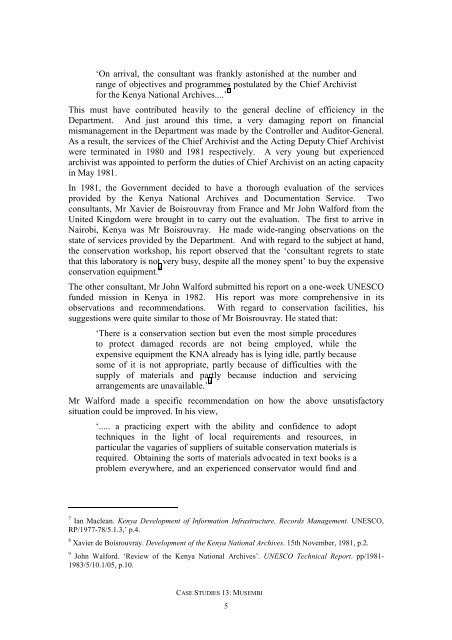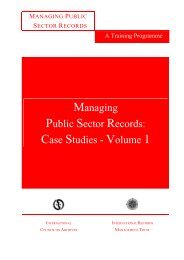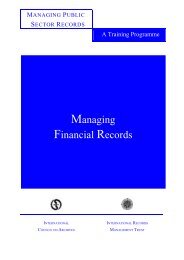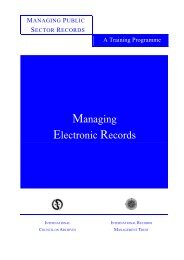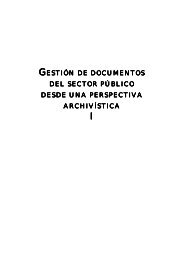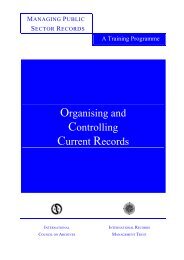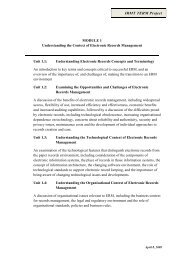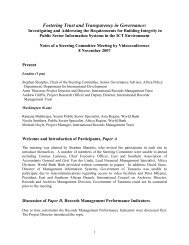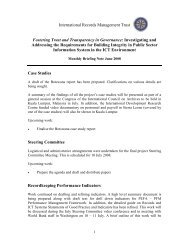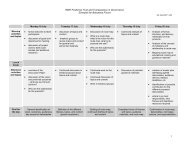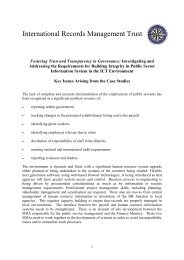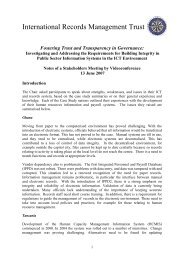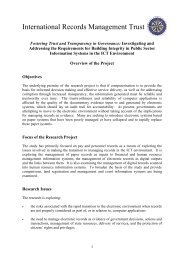managing public sector records: a study programme - International ...
managing public sector records: a study programme - International ...
managing public sector records: a study programme - International ...
Create successful ePaper yourself
Turn your PDF publications into a flip-book with our unique Google optimized e-Paper software.
‘On arrival, the consultant was frankly astonished at the number and<br />
range of objectives and <strong>programme</strong>s postulated by the Chief Archivist<br />
for the Kenya National Archives....’ 7<br />
This must have contributed heavily to the general decline of efficiency in the<br />
Department. And just around this time, a very damaging report on financial<br />
mismanagement in the Department was made by the Controller and Auditor-General.<br />
As a result, the services of the Chief Archivist and the Acting Deputy Chief Archivist<br />
were terminated in 1980 and 1981 respectively. A very young but experienced<br />
archivist was appointed to perform the duties of Chief Archivist on an acting capacity<br />
in May 1981.<br />
In 1981, the Government decided to have a thorough evaluation of the services<br />
provided by the Kenya National Archives and Documentation Service. Two<br />
consultants, Mr Xavier de Boisrouvray from France and Mr John Walford from the<br />
United Kingdom were brought in to carry out the evaluation. The first to arrive in<br />
Nairobi, Kenya was Mr Boisrouvray. He made wide-ranging observations on the<br />
state of services provided by the Department. And with regard to the subject at hand,<br />
the conservation workshop, his report observed that the ‘consultant regrets to state<br />
that this laboratory is not very busy, despite all the money spent’ to buy the expensive<br />
conservation equipment. 8<br />
The other consultant, Mr John Walford submitted his report on a one-week UNESCO<br />
funded mission in Kenya in 1982. His report was more comprehensive in its<br />
observations and recommendations. With regard to conservation facilities, his<br />
suggestions were quite similar to those of Mr Boisrouvray. He stated that:<br />
‘There is a conservation section but even the most simple procedures<br />
to protect damaged <strong>records</strong> are not being employed, while the<br />
expensive equipment the KNA already has is lying idle, partly because<br />
some of it is not appropriate, partly because of difficulties with the<br />
supply of materials and partly because induction and servicing<br />
arrangements are unavailable.’ 9<br />
Mr Walford made a specific recommendation on how the above unsatisfactory<br />
situation could be improved. In his view,<br />
‘..... a practicing expert with the ability and confidence to adopt<br />
techniques in the light of local requirements and resources, in<br />
particular the vagaries of suppliers of suitable conservation materials is<br />
required. Obtaining the sorts of materials advocated in text books is a<br />
problem everywhere, and an experienced conservator would find and<br />
7<br />
Ian Maclean. Kenya Development of Information Infrastructure, Records Management. UNESCO,<br />
RP/1977-78/5.1.3,’ p.4.<br />
8 Xavier de Boisrouvray. Development of the Kenya National Archives. 15th November, 1981, p.2.<br />
9<br />
John Walford. ‘Review of the Kenya National Archives’. UNESCO Technical Report. pp/1981-<br />
1983/5/10.1/05, p.10.<br />
CASE STUDIES 13: MUSEMBI<br />
5


